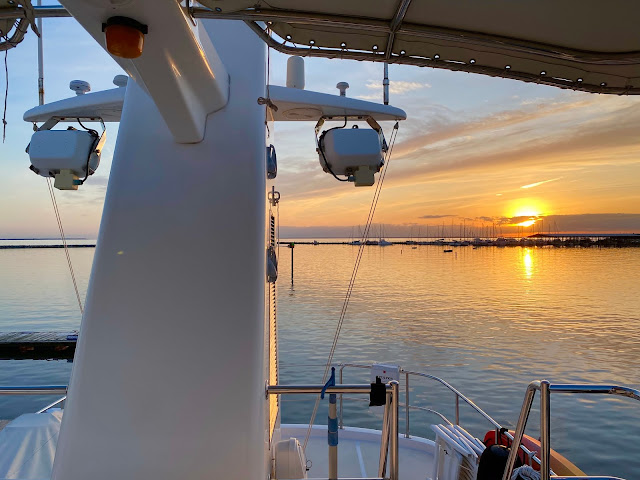Crab Pots: The Boating Mines Of The Chesapeake
The other day, while out on Chesapeake Bay, I asked my dad how crab traps work.
We see them every day we move the boat and sometimes it feels like we are tiptoeing through a minefield to avoid them.
My dad didn't know how they work, so he gave learning and reading about them to me as a blog assignment.
At first I really didn't want to do it, because I thought it would be boring. Especially after just writing about the Chesapeake Bay Astroid Impact. But maybe an assignment is only is boring as one makes it.
So here is my best effort to make this interesting and entertaining.
__________
The Maryland crab season runs from April 1 to December 15. But this year's harvest has already been impacted. According to the Maryland Department of Natural Resources (DNR), the 2020 Blue Crab Advisory Report shows that the crab population has decreased from 594,000,000 to 405,000,000, a decline of 189 million (-31%), from last year. Not to worry though. This happens naturally from time to time in the population.
Crab pots work by luring a crab toward bait, then trapping it. Crabs enter a cage, through strategically placed openings. The right sized crabs can't get out, but the smaller ones can.
The crab pot in this picture is a regular crab pot, used in shallower waters. It is made to catch Blue Crabs, the most common type here on the Chesapeake.
You probably noticed the colored rings in the picture above. They are called cull rings, and are very important for the crab trap. They are a minimum of 2 5/16 inches across.
This is how cull rings work.
All crab pots have a rope attached to the crab pot, which is attached to a buoy. This allows crabbers to find their pots. The rope needs to be longer than the depth of the water at high tide, or else the pots could be lifted off the bottom and float away.
The crab pots here in Maryland are small compared to some others.
Some giant crab pots can be as big as 149 cubic feet (7' x 7' x 3'). And can wait as much as 700 pounds. This one in the picture is from Alaska.
Crab pots are also a hazard to boating. While out on the Chesapeake, we constantly have to be on the lookout for them, because if we run into one, it could become wrapped around our propellor and/or shaft, and cause damage and/or disable us.
In the last few days, we have faced three of the greater challenges spotting crab pots. The first was high winds causing big waves. It's extra hard to spot crab pot buoys among whitecaps and when they bob down into wave troughs. The second challenge we faced was heavy rain. Reduced visibility makes them hard to spot too. We reduced speed. The last we faced was bright sunshine and glare. We learned it's almost impossible to spot crab traps when the sun is reflecting off the water right on our course. To overcome this, we zig zagged.
To our knowledge, we have only tangled with one crab trap. But we never saw it. We never even knew we had run over it until we had the boat hauled out for annual maintenance. There was the line.
So why wasn't there damage? Our boat has something on it designed to cut crab pot lines (and other lines) automatically, using the power of the engine and some strong sharp blades. It's simple and ingenious. It is called Spurs.
Our Spurs
Here is a video of how Spurs works. (It's kind of long, so maybe watch a minute or so.)
So that's how crab pots work and how they affect our travels on the Chesapeake and elsewhere.
Today, while I wrote this, I watched several smaller crab boats leave our marina. Here's one of them. This regional style of boat is called a "deadrise." FYI, deadrise refers to the angle between a boat's keel, (on the bottom) and its chine (where the bottom meets the sides).
If you want to learn what it's like to be a crabber on the Chesapeake, here's an interesting video called "Another Day's Catch."
- Salter
P.S. I said I'd try to make this subject interesting. Here are some funny Gary Larson cartoons about crabs.
P.P.S. And, here's one last bit of crab humor.















Salter, you sure are learning how to make your posts even better. Interesting topics, thorough research, plenty of great pictures, informative videos, and humor! I like the crab boxer and, of course, the crab scene from Nemo the best. I may not be able to be there with you and Dad, but I kind of feel like I am when I read your blog. So thank you. Can't wait to see you guys. Love, Mom.
ReplyDeleteSalter this is such an interesting and informative post! You are becoming a wonderful writer. Keep it up😊 Love, Aunt Rosie
ReplyDeleteSalter, keep it up! If you and Cpt Alex ever get to the Gulf of Mexico you will find many more crab pots. I don't know how we missed all of them. Some of it just dumb luck. Add to it we don't have the cutters on the shafts so we easily could have pulled them up from the bottom into the props. Have fun!
ReplyDeleteNR (Ask your dad)
I happen to be a big fan of crabs, delicious! Did you have any crab cakes or other dishes? At a certain time of the year the crab shells are soft and you can eat the whole crab, shell and all. They’re a big hit in New Orleans. Now I know how they catch those tasty critters!
ReplyDelete